2013 VOLKSWAGEN PASSAT towing
[x] Cancel search: towingPage 211 of 379

not always be able to help you master situations where there is a sudden change in the coefficient of
friction of the road surface. When there is a section of dry road that is suddenly covered with water,
slush or snow, ESC cannot perform the same way it would on a dry surface. If the vehicle
“hydroplanes” (rides on a cushion of water instead of the road surface), ESC will not be able to help
you steer the vehicle because contact with the pavement has been interrupted and the vehicle cannot
be braked or steered. During fast cornering, particularly on winding roads, ESC cannot always deal as
effectively with difficult driving situations as it can at lower speeds. When towing a trailer, ESC is not
able to help you regain control as it would if you were not towing a trailer.
Always adjust your speed and driving style to visibility, road, traffic, and weather conditions. ESC
cannot override the vehicle's physical limits, increase the available traction, or keep a vehicle on the
road if road departure is a result of driver inattention. Instead, ESC improves the possibility of keeping
the vehicle under control and on the road during extreme maneuvers by using the driver's steering
inputs to help keep the vehicle going in the intended direction. If you are traveling at a speed that
causes you to run off the road before ESC can provide any assistance, you may not experience the
benefits of ESC.
ESC includes and/or works together with the ABS, BAS, ASR, EDL, and XDL systems (see below).
ESC is switched on all the time and cannot be switched off.
Anti-Lock Brake System (ABS)
ABS helps to keep the wheels from locking up and helps to maintain the driver's ability to steer and
control the vehicle. This means the vehicle is less likely to skid, even during hard braking:
�x Push the brake pedal down hard and hold it there. Don't take your foot off the pedal or reduce the
force on the pedal!
�x Do not “pump” the brake pedal or let up on it!
�x Steer the vehicle while pushing down hard on the brake pedal.
�x ABS stops working if you release or let up on the brake.
When ABS is doing its job, you will notice a slight vibration through the brake pedal and hear a
noise. ABS cannot shorten the stopping distance under all conditions. The stopping distance may
even be longer, for instance, when driving on gravel or on newly fallen snow covering an icy or
slippery surface.
Brake Assist (BAS)
The Brake Assist System can help to reduce stopping distances. If you press the brake pedal very
quickly, BAS detects an emergency situation. It then very quickly builds up full brake system pressure,
maximizing braking power and reducing the stopping distance. This way, ABS can be activated more
quickly and efficiently.
Do not reduce pressure on the brake pedal! BAS switches off automatically as soon as you release or
let up on the brake.
Anti-Slip Regulation (ASR)
ASR reduces engine power directed to spinning wheels and adjusts power to the road conditions.
Even under poor road conditions, ASR can make it easier to get moving, accelerate, and climb hills.
ESC and ASR can help when driving on loose surfaces (such as gravel) and in deep snow. If you get
stuck in deep snow, you may be able to get going again by “rocking” the vehicle back and forth. ESC
and ASR recognize this special driving situation and automatically increase the speed of the front
wheels. Keep pressing the accelerator and let ESC increase the speed of the front wheels to help you
keep moving or get moving again.
Electronic Differential Lock (EDL and XDL)
EDL is applied during regular straight-line acceleration. EDL gently brakes a drive wheel that has lost
traction (spinning) and redirects the drive force to other drive wheels. In extreme cases, EDL
automatically switches off to keep the brake from overheating. As soon as the brake has cooled down,
EDL automatically switches on again.
Page 218 of 379
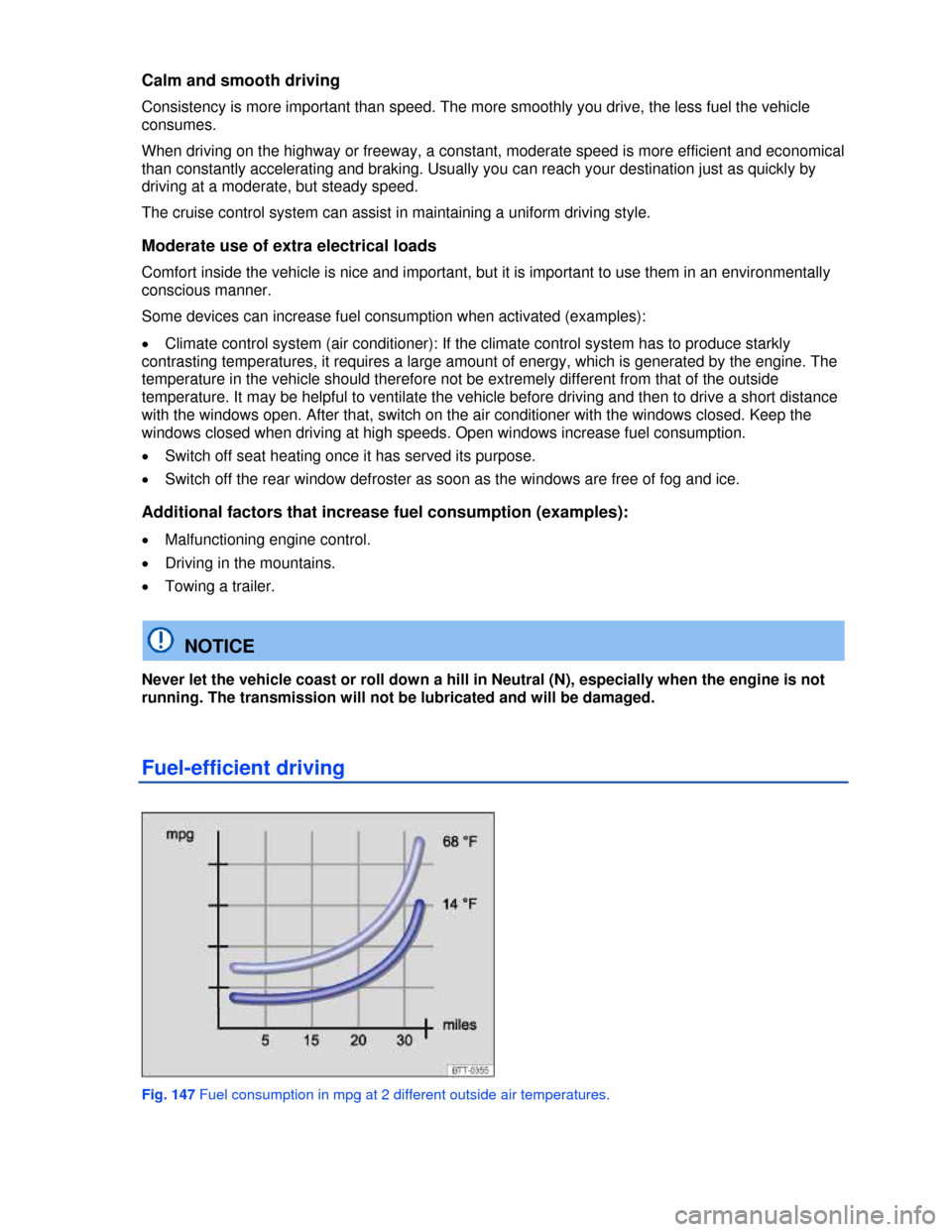
Calm and smooth driving
Consistency is more important than speed. The more smoothly you drive, the less fuel the vehicle
consumes.
When driving on the highway or freeway, a constant, moderate speed is more efficient and economical
than constantly accelerating and braking. Usually you can reach your destination just as quickly by
driving at a moderate, but steady speed.
The cruise control system can assist in maintaining a uniform driving style.
Moderate use of extra electrical loads
Comfort inside the vehicle is nice and important, but it is important to use them in an environmentally
conscious manner.
Some devices can increase fuel consumption when activated (examples):
�x Climate control system (air conditioner): If the climate control system has to produce starkly
contrasting temperatures, it requires a large amount of energy, which is generated by the engine. The
temperature in the vehicle should therefore not be extremely different from that of the outside
temperature. It may be helpful to ventilate the vehicle before driving and then to drive a short distance
with the windows open. After that, switch on the air conditioner with the windows closed. Keep the
windows closed when driving at high speeds. Open windows increase fuel consumption.
�x Switch off seat heating once it has served its purpose.
�x Switch off the rear window defroster as soon as the windows are free of fog and ice.
Additional factors that increase fuel consumption (examples):
�x Malfunctioning engine control.
�x Driving in the mountains.
�x Towing a trailer.
NOTICE
Never let the vehicle coast or roll down a hill in Neutral (N), especially when the engine is not
running. The transmission will not be lubricated and will be damaged.
Fuel-efficient driving
Fig. 147 Fuel consumption in mpg at 2 different outside air temperatures.
Page 290 of 379

Tire inflation pressure in cold tires
Tread depth and tread wear indicators
Tire wear and damage
Compact spare wheel
Tire labeling
Tire efficiency label
Winter tires
Snow chains
Glossary of tire and loading terminology
Tires and vehicle load limits
Determining the correct load limit
Volkswagen recommends that all work on tires and wheels be done by an authorized Volkswagen
dealer or authorized Volkswagen Service Facility. They are familiar with the technical requirements
and recommended procedures, have the necessary special tools and spare parts, and can properly
dispose of old tires.
More information:
�x Transporting
�x Trailer towing
�x Braking, stopping and parking
�x Tire Pressure Monitoring System
�x Exterior care and cleaning
�x Vehicle tool kit
�x Consumer information
�x Wheel covers
�x Changing a wheel
Page 344 of 379
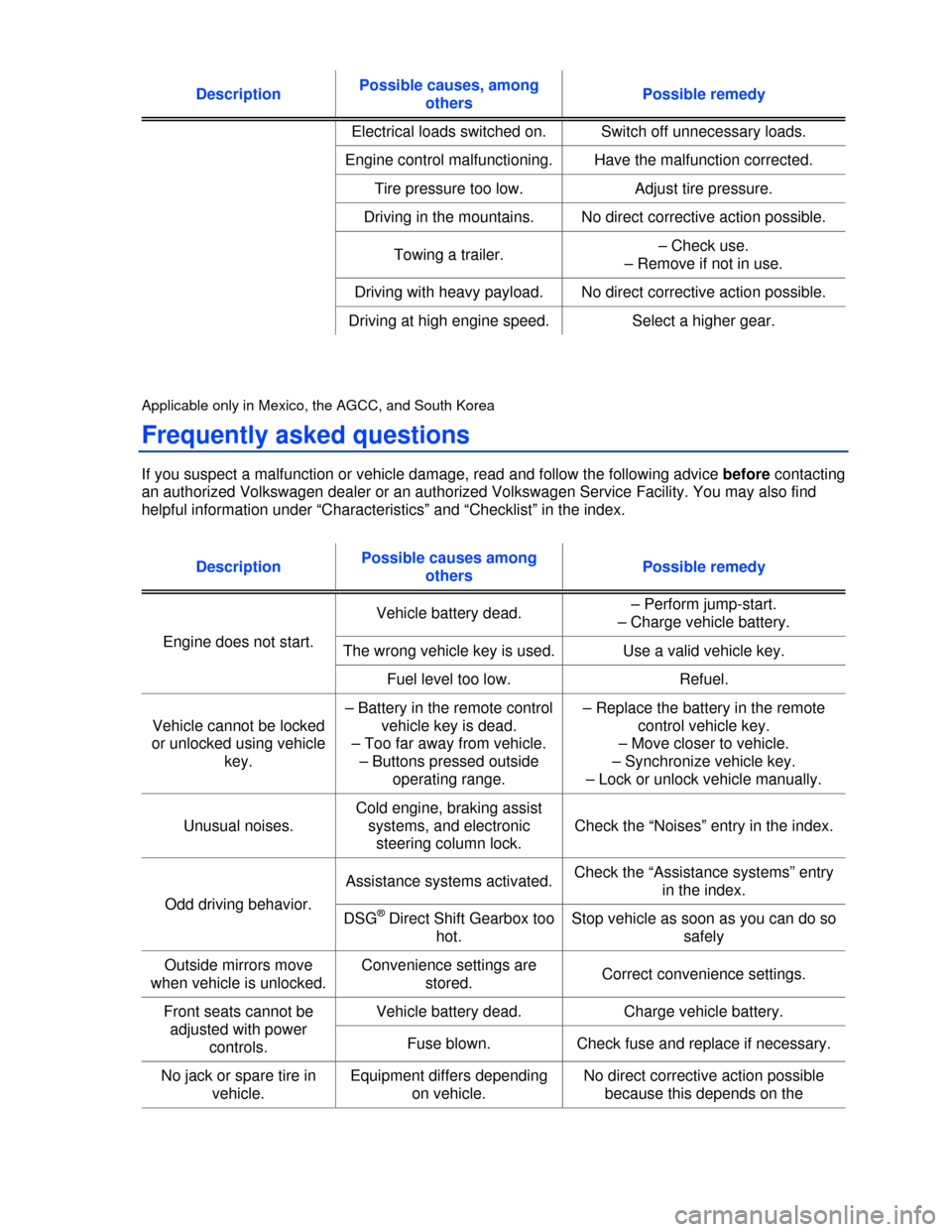
Description Possible causes, among
others Possible remedy
Electrical loads switched on. Switch off unnecessary loads.
Engine control malfunctioning. Have the malfunction corrected.
Tire pressure too low. Adjust tire pressure.
Driving in the mountains. No direct corrective action possible.
Towing a trailer. – Check use.
– Remove if not in use.
Driving with heavy payload. No direct corrective action possible.
Driving at high engine speed. Select a higher gear.
Applicable only in Mexico, the AGCC, and South Korea
Frequently asked questions
If you suspect a malfunction or vehicle damage, read and follow the following advice before contacting
an authorized Volkswagen dealer or an authorized Volkswagen Service Facility. You may also find
helpful information under “Characteristics” and “Checklist” in the index.
Description Possible causes among
others Possible remedy
Engine does not start.
Vehicle battery dead. – Perform jump-start.
– Charge vehicle battery.
The wrong vehicle key is used. Use a valid vehicle key.
Fuel level too low. Refuel.
Vehicle cannot be locked
or unlocked using vehicle
key.
– Battery in the remote control
vehicle key is dead.
– Too far away from vehicle.
– Buttons pressed outside
operating range.
– Replace the battery in the remote
control vehicle key.
– Move closer to vehicle.
– Synchronize vehicle key.
– Lock or unlock vehicle manually.
Unusual noises.
Cold engine, braking assist
systems, and electronic
steering column lock.
Check the “Noises” entry in the index.
Odd driving behavior.
Assistance systems activated. Check the “Assistance systems” entry
in the index.
DSG® Direct Shift Gearbox too
hot.
Stop vehicle as soon as you can do so
safely
Outside mirrors move
when vehicle is unlocked.
Convenience settings are
stored. Correct convenience settings.
Front seats cannot be
adjusted with power
controls.
Vehicle battery dead. Charge vehicle battery.
Fuse blown. Check fuse and replace if necessary.
No jack or spare tire in
vehicle.
Equipment differs depending
on vehicle.
No direct corrective action possible
because this depends on the
Page 345 of 379

Description Possible causes among
others Possible remedy
Vehicle has run-flat or mobility
tires.
equipment. Contact an authorized
Volkswagen dealer or an authorized
Volkswagen Service Facility for
assistance.
Features do not work as
described in this manual.
Settings were adjusted in the
Volkswagen Information
System.
Check and reset to factory settings if
necessary.
Headlights do not light up
the road as they should.
– Headlights adjusted too high.
– Light bulbs burned out.
– Low beams not switched on.
– Have the headlight range adjusted by
an authorized Volkswagen dealer or an
authorized Volkswagen Service
Facility.
– Change light bulbs.
– Switch on low beams.
Electrical consumers do
not work.
Vehicle battery charge too low. Charge vehicle battery.
Remaining fuel level too low. Refuel.
Fuse blown. Check fuse and replace if necessary.
Fuel consumption higher
than indicated.
– Short hauls.
– “Jumpy” accelerator pedal.
– Avoid short distance driving.
– Drive defensively.
– Accelerate smoothly.
Electrical loads switched on. Switch off unnecessary loads.
Engine control malfunctioning. Have the malfunction corrected.
Tire pressure too low. Adjust tire pressure.
Driving in the mountains. No direct corrective action possible.
Towing a trailer. – Check use.
– Remove if not in use.
Driving with heavy payload. No direct corrective action possible.
Driving at high engine speed. Select a higher gear.
Page 364 of 379
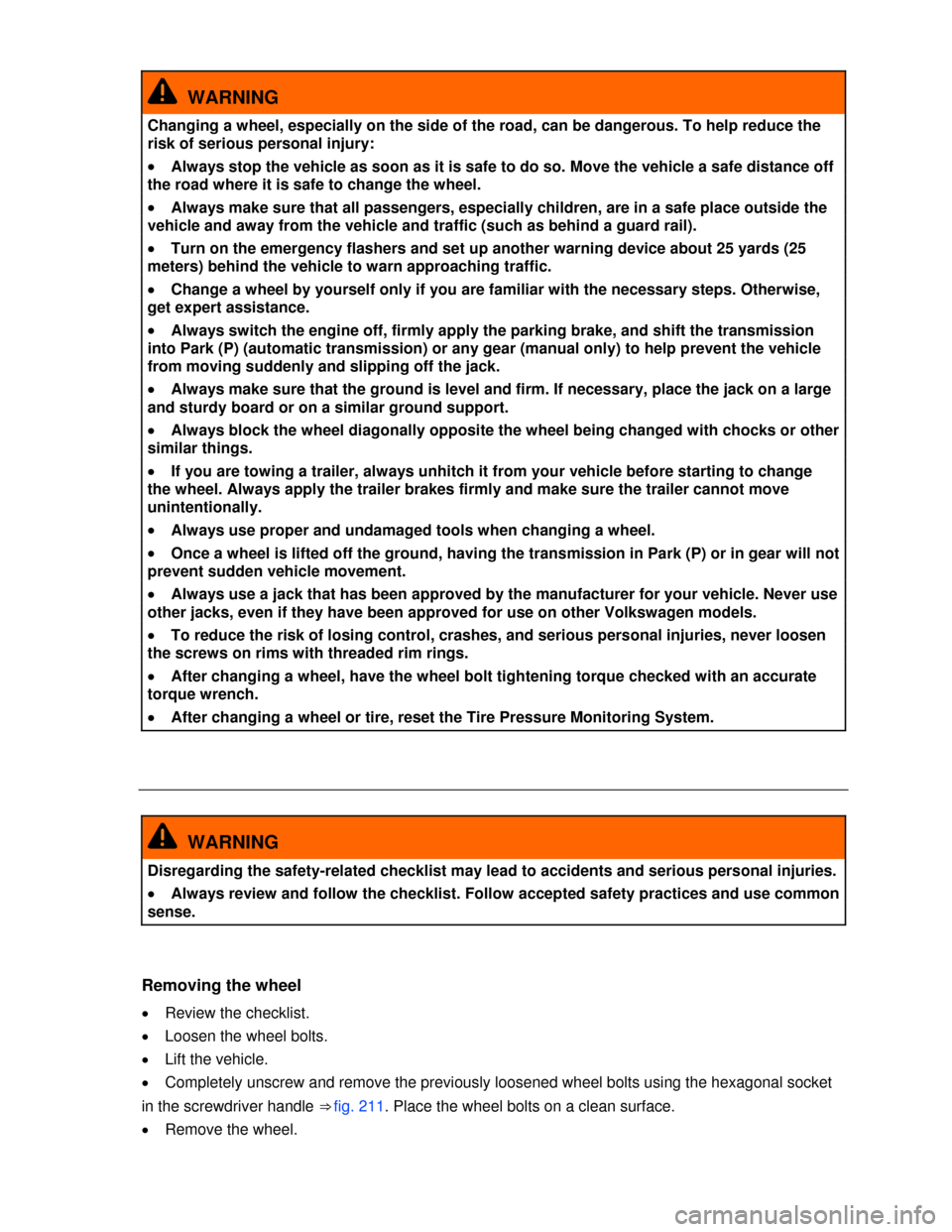
WARNING
Changing a wheel, especially on the side of the road, can be dangerous. To help reduce the
risk of serious personal injury:
�x Always stop the vehicle as soon as it is safe to do so. Move the vehicle a safe distance off
the road where it is safe to change the wheel.
�x Always make sure that all passengers, especially children, are in a safe place outside the
vehicle and away from the vehicle and traffic (such as behind a guard rail).
�x Turn on the emergency flashers and set up another warning device about 25 yards (25
meters) behind the vehicle to warn approaching traffic.
�x Change a wheel by yourself only if you are familiar with the necessary steps. Otherwise,
get expert assistance.
�x Always switch the engine off, firmly apply the parking brake, and shift the transmission
into Park (P) (automatic transmission) or any gear (manual only) to help prevent the vehicle
from moving suddenly and slipping off the jack.
�x Always make sure that the ground is level and firm. If necessary, place the jack on a large
and sturdy board or on a similar ground support.
�x Always block the wheel diagonally opposite the wheel being changed with chocks or other
similar things.
�x If you are towing a trailer, always unhitch it from your vehicle before starting to change
the wheel. Always apply the trailer brakes firmly and make sure the trailer cannot move
unintentionally.
�x Always use proper and undamaged tools when changing a wheel.
�x Once a wheel is lifted off the ground, having the transmission in Park (P) or in gear will not
prevent sudden vehicle movement.
�x Always use a jack that has been approved by the manufacturer for your vehicle. Never use
other jacks, even if they have been approved for use on other Volkswagen models.
�x To reduce the risk of losing control, crashes, and serious personal injuries, never loosen
the screws on rims with threaded rim rings.
�x After changing a wheel, have the wheel bolt tightening torque checked with an accurate
torque wrench.
�x After changing a wheel or tire, reset the Tire Pressure Monitoring System.
WARNING
Disregarding the safety-related checklist may lead to accidents and serious personal injuries.
�x Always review and follow the checklist. Follow accepted safety practices and use common
sense.
Removing the wheel
�x Review the checklist.
�x Loosen the wheel bolts.
�x Lift the vehicle.
�x Completely unscrew and remove the previously loosened wheel bolts using the hexagonal socket
in the screwdriver handle ⇒ fig. 211. Place the wheel bolts on a clean surface.
�x Remove the wheel.
Page 374 of 379
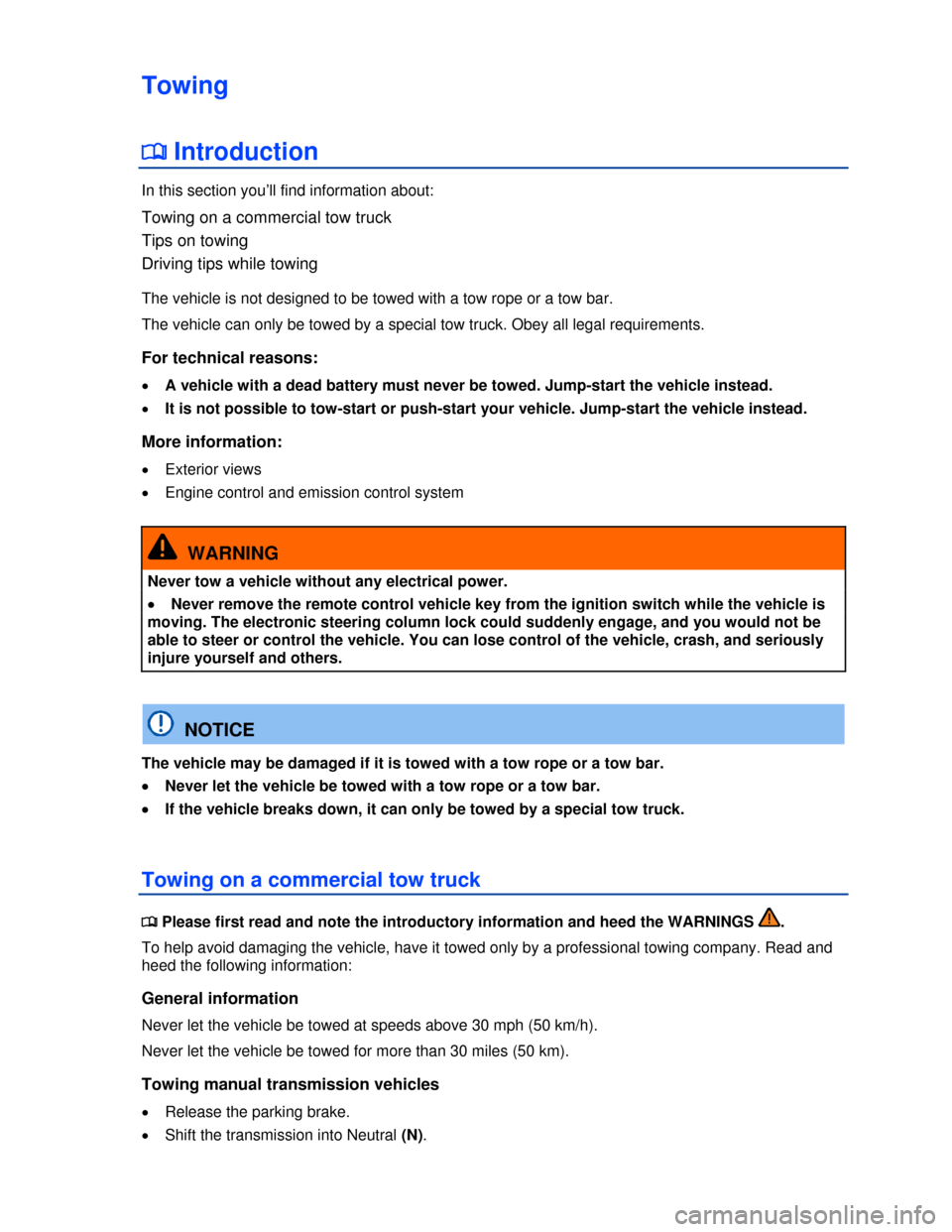
Towing
�
Page 375 of 379
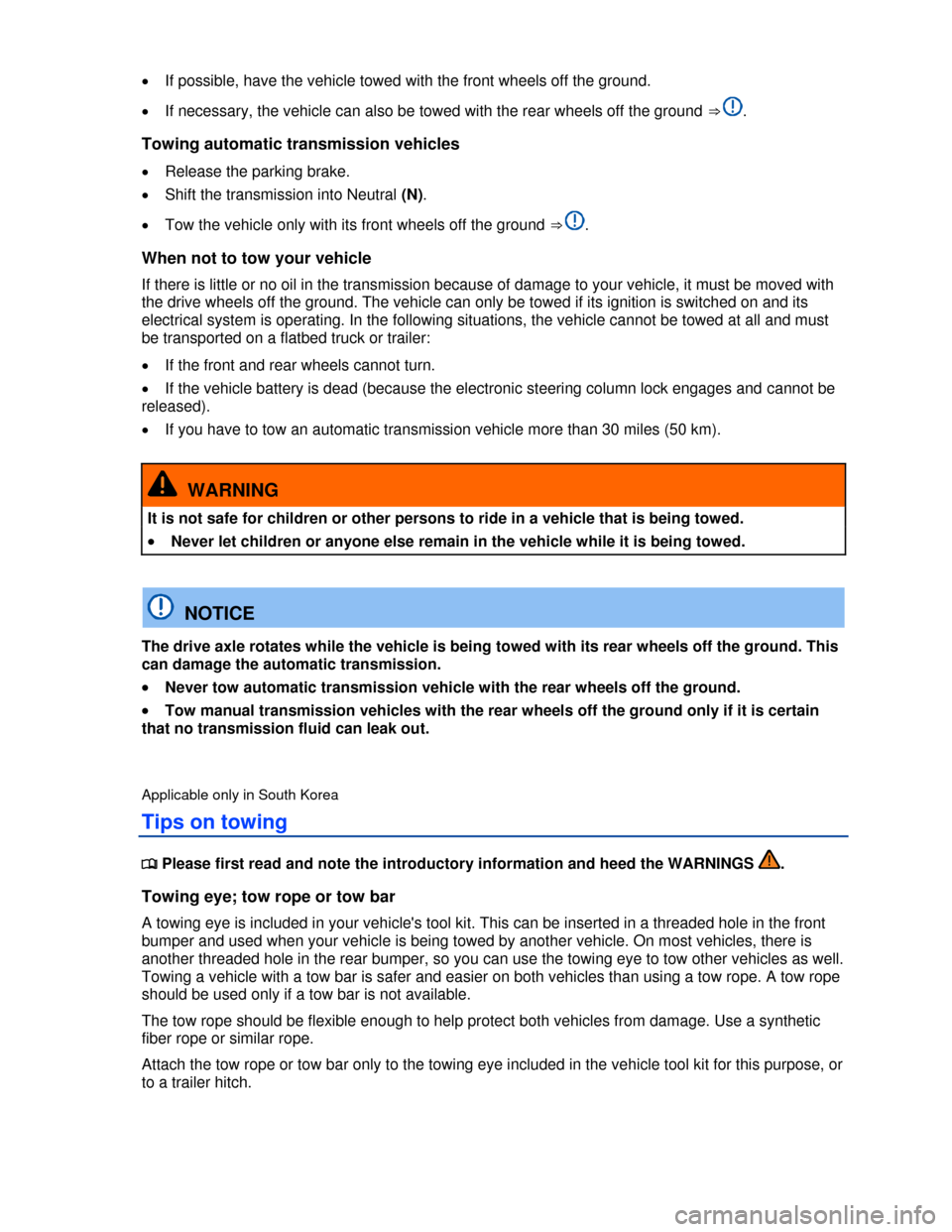
�x If possible, have the vehicle towed with the front wheels off the ground.
�x If necessary, the vehicle can also be towed with the rear wheels off the ground ⇒ .
Towing automatic transmission vehicles
�x Release the parking brake.
�x Shift the transmission into Neutral (N).
�x Tow the vehicle only with its front wheels off the ground ⇒ .
When not to tow your vehicle
If there is little or no oil in the transmission because of damage to your vehicle, it must be moved with
the drive wheels off the ground. The vehicle can only be towed if its ignition is switched on and its
electrical system is operating. In the following situations, the vehicle cannot be towed at all and must
be transported on a flatbed truck or trailer:
�x If the front and rear wheels cannot turn.
�x If the vehicle battery is dead (because the electronic steering column lock engages and cannot be
released).
�x If you have to tow an automatic transmission vehicle more than 30 miles (50 km).
WARNING
It is not safe for children or other persons to ride in a vehicle that is being towed.
�x Never let children or anyone else remain in the vehicle while it is being towed.
NOTICE
The drive axle rotates while the vehicle is being towed with its rear wheels off the ground. This
can damage the automatic transmission.
�x Never tow automatic transmission vehicle with the rear wheels off the ground.
�x Tow manual transmission vehicles with the rear wheels off the ground only if it is certain
that no transmission fluid can leak out.
Applicable only in South Korea
Tips on towing
�